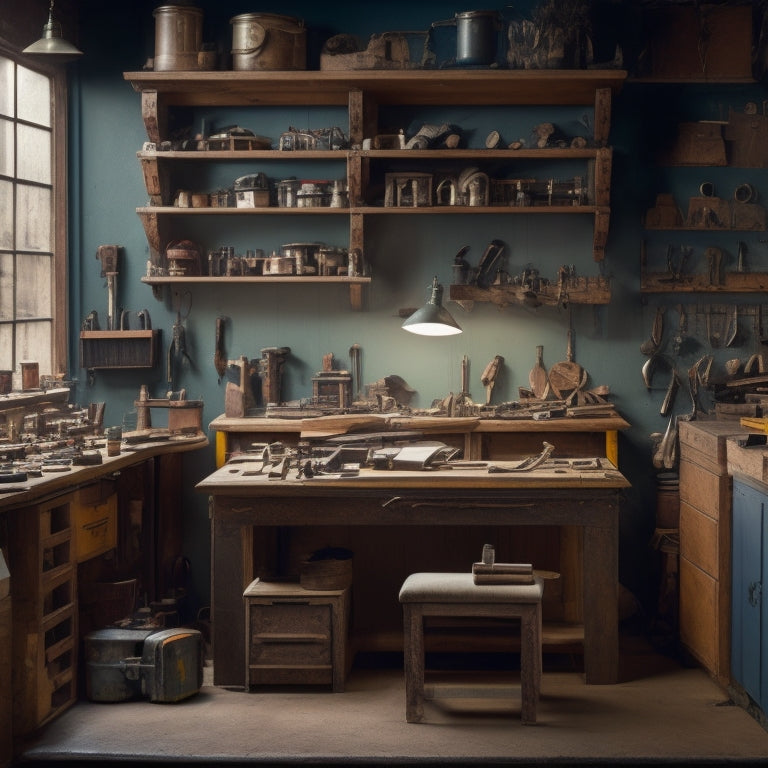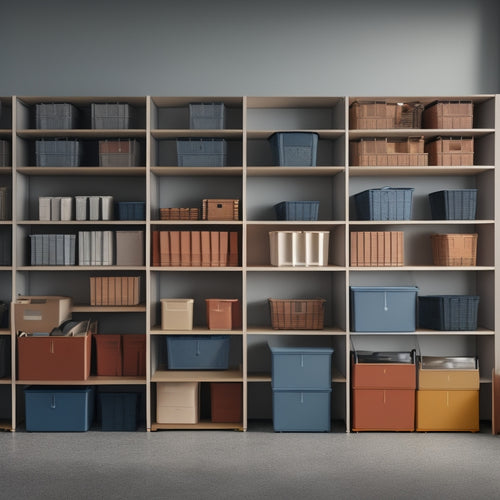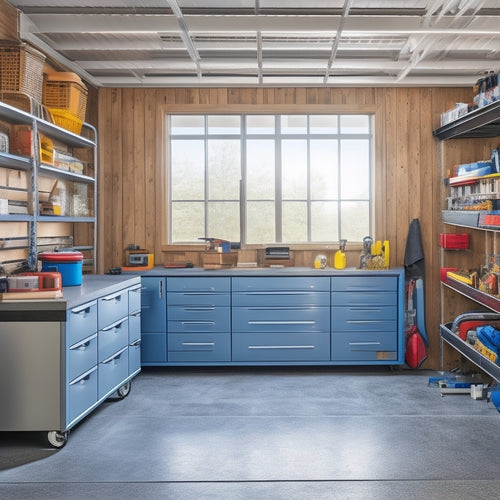
Work Bench Cabinet Buying Considerations
Share
When buying a workbench cabinet, you'll want to contemplate the cabinet size and configuration to guarantee it fits your workspace layout efficiently. Durable materials like steel and solid wood are ideal for heavy tools, and humidity and temperature conditions will impact material performance. Storage capacity should align with your tool usage, with smooth-gliding drawer tracks and locking mechanisms for security. Additionally, ergonomic considerations like work surface height, adjustable features, and reduced strain risks should be prioritized. To make an informed decision, you'll need to weigh budget, brand reputation, and warranty, as well as customization options - and that's just the starting point for creating your ideal workspace solution.
Key Takeaways
- Consider cabinet size and configuration to ensure efficient workspace layout and tool storage access.
- Choose durable materials with a suitable finish to withstand humidity, temperature, and tool usage.
- Ensure adequate storage capacity and accessibility with smooth-gliding drawer tracks and customizable compartments.
- Opt for an ergonomic work surface with adjustable height features to promote comfort and reduce fatigue.
- Set a realistic budget and evaluate brand reputation, warranty, and customization options for long-term value.
Cabinet Size and Configuration
With your work bench cabinet, size and configuration are critical considerations that directly impact your workspace's efficiency and functionality. You need to determine the ideal cabinet dimensions that fit your workspace layout, guaranteeing a smooth workflow and minimizing congestion.
Consider the width, depth, and height of the cabinet, factoring in the space available and the type of tools and equipment you plan to store. A well-configured cabinet will provide easy access to your tools, reducing the risk of accidents and injuries.
When selecting a cabinet, think about the layout of your workspace. Will the cabinet be placed against a wall or in a corner? Do you need a compact cabinet for a small space or a larger one for a more extensive tool collection?
Consider the door swing and opening mechanism to ascertain it won't interfere with your workflow. By carefully considering these factors, you'll be able to choose a cabinet that optimizes your workspace, enhancing your productivity and safety.
Material Durability and Finish
Your work bench cabinet's material durability and finish are vital aspects to contemplate, as they substantially impact the cabinet's lifespan and overall aesthetic appeal.
When evaluating material types, consider the intended use of your cabinet. If you'll be storing heavy tools or equipment, look for durable materials like steel or solid wood that can withstand wear and tear. For lighter loads, medium-density fiberboard (MDF) or plywood may suffice.
Additionally, consider the humidity and temperature conditions in your workspace, as certain materials may be more prone to warping or degradation.
Finish options also play a significant role in your cabinet's durability and appearance. Powder-coated finishes, for instance, offer superior resistance to corrosion and scratches.
Alternatively, polyurethane or lacquer finishes can provide a protective barrier against moisture and spills.
Don't forget to inspect the finish's thickness and uniformity, as a subpar finish can compromise the cabinet's overall integrity.
Storage Capacity and Accessibility
As you've carefully selected the material and finish for your work bench cabinet, it's time to turn your attention to the storage capacity and accessibility features that will make a significant difference in your workflow. Contemplate the types of tools and equipment you'll be storing and the frequency of use. This will help you determine the ideal shelf organization, including the number and size of shelves, as well as their adjustability and configurability.
Drawer accessibility is another important aspect to reflect on. Look for cabinets with drawers that are easy to open and close, with smooth-gliding tracks and secure latches.
You'll also want to verify that the drawers are large enough to accommodate your bulkier items, while also providing compartments and dividers to keep smaller tools organized. Additionally, think about cabinets with locking mechanisms to secure essential equipment and prevent unauthorized access.
Work Surface Material Options
When selecting a work bench cabinet, you'll need to evaluate the work surface material that best suits your needs.
You'll have to choose between wood surface options, such as solid hardwood or engineered wood, which offer a traditional look and feel.
Alternatively, you can opt for durable laminate alternatives, which provide a low-maintenance and budget-friendly solution.
Wood Surface Options
The work surface of your workbench cabinet is a critical component, and the material chosen for it can greatly impact your overall working experience. When evaluating wood surface options, you'll want to weigh the benefits and drawbacks of each type.
Here are four wood surface options to evaluate:
-
Hardwood: Offers exceptional durability and resistance to scratches and dents. Hardwood benefits include a longer lifespan and a classic, professional look. However, it can be expensive and may require periodic refinishing.
-
Plywood: A cost-effective alternative to hardwood, plywood is made from layers of wood veneer pressed together. Plywood choices include birch, oak, and maple, each with its own unique characteristics. While it's less expensive than hardwood, plywood may not be as durable.
-
MDF (Medium-Density Fiberboard): A dense, flat, and affordable option. MDF is made from wood fibers pressed together with a bonding agent. It's a good choice for those on a budget, but it can be prone to water damage.
- Butcher Block: A hardwood surface made from glued-together wood strips. Butcher block is durable, resistant to scratches, and easy to clean. However, it can be expensive and may require periodic oiling to maintain its appearance.
When choosing a wood surface option, evaluate your budget, the type of projects you'll be working on, and your personal preferences for durability, maintenance, and aesthetics.
Durable Laminate Alternatives
Step up to durable laminate alternatives that can withstand the rigors of your workshop. When choosing a laminate work surface, you'll come across different types, each with its unique characteristics. High-pressure laminates (HPL) are a popular choice, offering exceptional resistance to scratches, heat, and chemicals.
Another option is compact laminates, which provide a solid, dense core that's less prone to water damage. You may also consider decorative laminates, which offer a stylish, wood-grain appearance without the maintenance requirements.
Regardless of the laminate type you select, proper maintenance is essential to extend its lifespan. Start by wiping down the surface with a damp cloth to remove dirt and debris. Avoid using harsh chemicals or abrasive cleaners, as they can damage the laminate.
For tougher stains, use a gentle cleaning product specifically designed for laminates. Regular maintenance will help prevent scratches and damage, ensuring your work surface remains safe and functional for years to come.
Ergonomic Considerations Matter
When choosing a work bench cabinet, you'll want to take into account how it will affect your body alignment, ensuring that you can stand comfortably with your arms at a 90-degree angle and your back straight.
A comfortable standing height is also vital, as it will help reduce fatigue and discomfort during long work sessions.
Body Alignment Matters
As you stand before your workbench, your body's natural posture plays a significant role in determining your overall comfort and productivity.
A well-designed workbench cabinet should provide adequate posture support to guarantee you can work efficiently without straining your muscles.
When considering a workbench cabinet, keep in mind the following alignment benefits:
-
Reduced back strain: A work surface that's at the correct height for your body will reduce the strain on your back and shoulders, allowing you to work for longer periods without fatigue.
-
Improved circulation: Proper body alignment promotes healthy blood flow, reducing the risk of discomfort, numbness, or tingling in your hands and feet.
-
Enhanced focus: When your body is comfortable, you can focus on the task at hand, leading to increased productivity and better work quality.
- Long-term health benefits: Good posture support can help prevent long-term musculoskeletal disorders, guaranteeing you can continue working safely and efficiently for years to come.
Comfortable Standing Height
Your body's natural posture is just the starting point for a comfortable and productive work experience. When selecting a work bench cabinet, consider a standing height that allows you to maintain this posture while working.
An adjustable height feature is vital to accommodate your unique comfort requirements. This feature enables you to customize the work surface to your ideal standing height, promoting standing comfort and reducing fatigue.
When adjusting the height, verify it's within the recommended range for your body type. Typically, this range falls between 29 and 45 inches. Adjusting the height to your comfort zone allows you to maintain a neutral spine, relaxed shoulders, and open hips.
This, in turn, enhances your overall productivity and focus. Look for work bench cabinets with adjustable height mechanisms that are smooth, quiet, and easy to operate. This will allow you to effortlessly switch between sitting and standing throughout your work session, promoting comfort and reducing the risk of discomfort or injury.
Reduced Strain Risks
Throughout an average workday, you'll likely spend a significant amount of time interacting with your work bench cabinet. This prolonged interaction can lead to strain and discomfort if your cabinet isn't designed with ergonomics in mind.
Strain reduction is essential to maintaining your overall well-being and productivity. When selecting a work bench cabinet, prioritize safety features that promote strain reduction.
To minimize the risk of strain, look for the following features:
- Adjustable shelving: This allows you to customize the storage space to fit your needs, reducing the need for excessive bending or stretching.
- Ergonomic handle design: Handles that fit comfortably in your hand and are positioned at a convenient height can reduce strain on your back and joints.
- Sliding drawers and doors: These features enable easy access to contents without requiring you to reach or bend excessively.
- Soft-close mechanisms: These slow the closure of drawers and doors, reducing the impact on your hands and wrists.
Budget and Cost Effectiveness
Setting a realistic budget is essential when shopping for a workbench cabinet, as it determines the quality and features you can afford.
You'll want to evaluate not only the initial cost but also the long-term value of your investment. A higher-priced cabinet with durable materials and sturdy construction may be more cost-effective in the long run, as it will require less maintenance and replacement.
When making a value comparison, think about the features that matter most to you.
Do you need advanced storage options, customizable compartments, or integrated tool holders? Are you willing to compromise on quality to stay within your budget, or would you rather invest in a premium product that will last for years to come?
As you weigh your options, remember that a workbench cabinet is a long-term investment in your safety and productivity.
Brand Reputation and Warranty
When evaluating workbench cabinets, you've likely taken into account the budget and cost-effectiveness of different options.
However, it's equally important to reflect on the brand reputation and warranty offered by the manufacturer. A reputable brand with an extensive warranty can provide peace of mind and protect your investment.
Here are 4 key factors to reflect on when evaluating brand reputation and warranty:
-
Brand Loyalty: Research the brand's history and customer loyalty. Do they've a track record of producing high-quality products and standing behind their work?
-
Customer Reviews: Read reviews from multiple sources to get a sense of the brand's reliability and customer satisfaction.
-
Warranty Terms: Carefully review the warranty terms, including the length of coverage, what's covered, and any limitations or exclusions.
- Customer Support: Evaluate the brand's customer support, including their response time, knowledge, and willingness to help with any issues that may arise.
Customization and Special Features
Your workbench cabinet's functionality and adaptability can greatly impact your workflow and productivity. When it comes to customization and special features, you'll want to contemplate what'll optimize your workspace.
Adjustable shelving, for instance, allows you to tailor the storage to your specific needs, ensuring that frequently used tools are within easy reach. This feature is particularly useful if you have oversized or irregularly shaped equipment.
Tool organization is another essential aspect to contemplate. Look for cabinets with built-in tool organizers, such as pegboards or trays, to keep your workspace clutter-free and prevent accidents. Some cabinets may also offer customizable inserts or dividers to further tailor the storage to your specific tools and supplies.
Additionally, think about features like electrical outlets, USB ports, or LED lighting, which can enhance your workflow and reduce fatigue.
Frequently Asked Questions
Can I Install a Workbench Cabinet on Uneven or Sloping Floors?
You can install a workbench cabinet on uneven or sloping floors, but you'll need to implement leveling solutions and floor stabilization measures to guarantee a secure and safe setup, preventing potential hazards and damage.
Are Workbench Cabinets Suitable for Outdoor or Garage Use?
When considering outdoor or garage use, you'll need to guarantee your workbench cabinet is weather-resistant and made with durable materials that can withstand harsh conditions, such as moisture, extreme temperatures, and UV exposure.
Can I Add Casters or Wheels to a Workbench Cabinet?
You'll be moving mountains with ease when you add casters to your workbench cabinet! You can choose from soft-wheel, hard-wheel, or ball-bearing caster types, guaranteeing a smooth ride, but first, check the weight capacity to confirm a safe and stable setup.
Are Workbench Cabinets Compatible With Different Power Outlet Types?
When selecting a workbench cabinet, you'll want to verify it's compatible with your power outlet type, considering electrical requirements like voltage, frequency, and plug type, to assure safe and efficient operation, avoiding electrical hazards and downtime.
Can I Integrate a Workbench Cabinet With Existing Workshop Furniture?
You're probably thinking, 'Can I even fit one more piece of furniture in my cramped workshop?' But, astonishingly, you can integrate a workbench cabinet with existing furniture, optimizing space and harmonizing design aesthetics for a seamless, safe workflow!
Conclusion
You've got a workbench cabinet that's the ultimate breakthrough - a behemoth of organization, a titan of tool storage, and a masterwork in ergonomic design. With its rugged durability, spacious storage, and customizable features, it's the holy grail of workshop wonders. Your workbench cabinet is the stuff of legends, a mythical creature that'll make your workflow so smooth, so efficient, and so productive that you'll be the envy of every DIY enthusiast and pro contractor within a 5-mile radius!
Related Posts
-

Choosing the Right Stacked Storage Bins
When choosing the right stacked storage bins, you'll want to evaluate your storage needs, considering inventory types...
-

Building Garage Shelves in 7 Easy Steps
You're about to convert your garage into a highly functional storage space by building custom shelves in just 7 easy ...
-

Top Rolling Tool Box Drawers for Maximum Storage
When it comes to maximizing storage with rolling tool box drawers, you need a solution that combines durability, cust...


